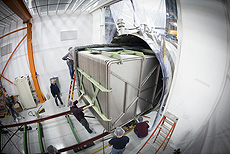MicroBooNE installs time projection chamber inside vessel, prepares for move
 |
A crew installed MicroBooNE's 5-ton time projection chamber in its cryostat last month. Photo: Reidar Hahn |
On Dec. 20, Fermilab collaborators on the MicroBooNE experiment successfully installed the time projection chamber in the experiment's vessel at the DZero assembly building.
The completion of this step is a milestone in the experiment's years-long narrative. Once the detector is moved to the new Liquid-Argon Test Facility, MicroBooNE scientists can begin a new stage of exploration of the behavior of chargeless, subatomic particles called neutrinos.
Even though neutrinos are all around us, they are not fully understood. One of scientists' longstanding questions about neutrinos is how one type morphs into another. MicroBooNE aims to address this and other questions and better explain neutrinos' role in the universe.
Once MicroBooNE is up and running, experimenters will shoot beams of neutrinos, manufactured at Fermilab, into the 10-meter-long time projection project chamber, which is filled with 89 tons of liquid argon and sits inside a silo-like vessel called a cryostat. When one of the neutrinos hits an argon nucleus, it will release particles, some of which are charged. This interaction, while it happens in the blink of an eye, will take many months to decipher. Thus scientists make sure that the detector "takes pictures" of all that goes on in its dark, cavernous depths.
As part of that process, the experiment uses a uniform, high-voltage electric field across the cage-like frame of the time projection chamber. This ensures that, when a charged particle is released, it will travel through the liquid argon, stripping electrons off the argon atoms along the way. The electrons in turn are directed along the electric field to the wires that are positioned along one side of the detector.
These delicate, gilded wires — all 8,256 of them — took MicroBooNE team members about two months to hand-string across the TPC. They "take the pulse" of each charged particle traversing the TPC and send information about its interaction to researchers' computers.
This information is translated into pixels, where each pixel represents the wire that recorded the interaction and each line of pixels represents that wire over time (usually a few microseconds, which is fairly long in particle physics). This "projection" of each wire's activity over a period of time is where the time projection chamber gets its name, explained Jonathan Asaadi, a postdoc from Syracuse University working on the experiment.
The wires are angled three different ways — vertically, and rotated 60 degrees to the left and right — so that a computer can construct a 3-D image of the interaction.
MicroBooNE researchers use a computer algorithm — a similar type of algorithm, in fact, used for facial recognition in airport security — to try to interpret these images and find anomalies. Their different shapes and patterns indicate which type of neutrino was involved in the interaction.
"By looking at interactions in our detector, we can measure the effective rate at which our neutrinos are changing form," said Fermilab's Jennifer Raaf, co-construction manager for MicroBooNE. "That tells us something, fundamentally, about physics."
Not only this, but MicroBooNE's experimenters aim to demonstrate the detector technology needed for the proposed Long-Baseline Neutrino Experiment. LBNE's multi-kiloton detector would be a far more massive, higher-voltage version of MicroBooNE's.
The collaboration is now hooking up the TPC's cables, after which they'll test the electronics, cover the open end of the TPC with an endcap and weld the whole thing shut. Then the detector is ready for its move to the Liquid-Argon Test Facility.
"We've been assembling the TPC for more than a year now, so it's a great feeling to finally have it sitting on its resting pads inside the cryostat," Raaf said. "Hopefully, the next steps will go as smoothly as the insertion did."
—Sarah Witman
|